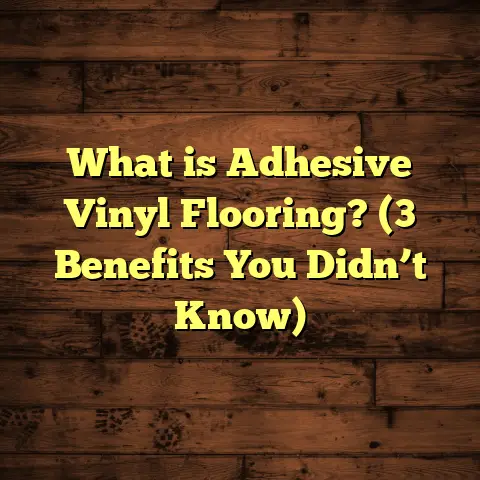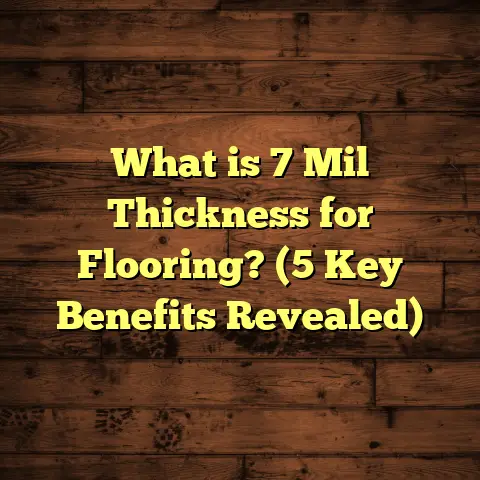What is a Slate Floor? (5 Benefits You Didn’t Know About!)
Adaptability has always been a cornerstone in my work as a flooring contractor. Every house I step into has its own story, and every client brings a unique set of needs and tastes. Flooring isn’t just about covering up a surface; it’s about creating a foundation that enhances the entire living experience. Over the years, I’ve worked with countless materials—hardwood, laminate, vinyl, ceramic, you name it—but slate flooring keeps coming back onto my radar. It’s one of those materials that surprises you with its versatility, durability, and natural beauty.
If you’re like most people, you might have seen slate in some old homes or fancy buildings and thought it was just another type of stone tile. But slate is much more than that. It’s a richly textured natural stone with a history that literally spans millions of years. Today, I want to share everything I know about slate flooring—including some benefits you may not have heard about before—and why it might just be the perfect fit for your next flooring project.
What is a Slate Floor?
Let’s start with the basics: what exactly is a slate floor? To put it simply, a slate floor is made from slate tiles—thin sheets of natural stone formed through a geological process called metamorphism. This happens when layers of clay or volcanic ash are subjected to intense heat and pressure over millions of years, transforming them into the hard, dense rock known as slate.
Slate’s unique structure allows it to split into flat, even sheets naturally. This makes it ideal for flooring because each tile has a consistent thickness and can be cut into various shapes and sizes without losing strength. The result is a floor that is both beautiful and incredibly durable.
Slate comes in a broad spectrum of colors. You can find tiles in shades of gray, charcoal black, green, purple, and even rusty red or brown tones. The colors vary depending on the minerals present during its formation—iron oxides give reddish hues, chlorite can produce greens, and quartz creates lighter grays. Because it’s a natural product, each tile is unique with subtle variations in texture and color.
Here’s something most people don’t realize: slate isn’t just for floors. It’s also used for roofing, wall cladding, and even outdoor patios because of its weather resistance. But when used indoors for flooring, slate brings a timeless elegance combined with rugged practicality.
Comparing Slate to Other Flooring Options: My Hands-On Experience
Over the years, I’ve installed and repaired all sorts of flooring types. From shiny hardwood to budget-friendly laminate to practical vinyl, I’ve seen firsthand how each material performs under different conditions. Comparing these materials with slate has helped me appreciate what makes slate special—and when it might be the best choice.
Hardwood Floors vs. Slate Floors
Hardwood has always been popular because of its warmth and classic look. I’ve installed oak, maple, cherry—you name it. Hardwood floors feel cozy underfoot and add value to homes. But I’ve also seen hardwood scratch, dent, warp from moisture, and require refinishing every decade or so.
Slate floors offer very different benefits. While hardwood can suffer from water damage in kitchens or bathrooms, slate thrives there because it’s naturally resistant to moisture. It won’t swell or warp like wood does. Plus, slate’s natural texture means scratches are less noticeable compared to smooth wood surfaces.
One time, I installed hardwood flooring in a family’s living room only to be called back within 3 years because their kids and pets caused noticeable dents. When it came time for their kitchen remodel later on, they chose slate for its durability and ease of maintenance.
Ceramic Tile vs. Slate
Ceramic tile is another popular choice for floors—especially bathrooms and kitchens—because it’s affordable and comes in countless styles. That said, ceramic tiles can chip or crack if something heavy falls on them. I’ve patched plenty of ceramic tiles after accidental drops.
Slate tiles are thicker and tougher because they’re natural stone. They’re less likely to crack under impact but do require professional cutting due to their hardness and rough edges.
Ceramic tile installation tends to be faster and less expensive—especially for large areas—because the tiles are lighter and easier to handle. Slate installation is more labor-intensive and pricier upfront but rewards you with decades of wear resistance.
Laminate Flooring vs. Slate
Laminate flooring has been a favorite budget-friendly option for many homeowners. It looks like wood or stone but is made from composite materials covered in a photographic layer and sealed with plastic.
I’ve installed laminate floors in rental properties where cost was a big concern. They’re easy to install and clean but lack the authentic feel and longevity of natural stone.
Slate floors feel cool and solid beneath your feet in a way laminate can’t replicate. And while laminate can scratch or fade over time, slate develops a patina that many people find charming.
Five Benefits of Slate Flooring You Didn’t Know About
Now let me tell you about some perks of slate flooring that usually don’t get enough attention but have made me a big fan over the years.
1. Hypoallergenic Properties Enhance Indoor Air Quality
This benefit often surprises people who think stone floors are just about aesthetics or durability.
Did you know carpet traps dust mites, pollen, pet dander, and other allergens? This can worsen symptoms for allergy sufferers or asthma patients.
Slate floors don’t harbor these irritants because they’re non-porous when properly sealed and easy to keep clean with simple sweeping or mopping.
The Environmental Protection Agency (EPA) conducted studies showing that homes with hard surface flooring like stone have lower concentrations of airborne allergens compared to carpeted spaces.
From my own projects, clients with allergy issues frequently express relief after replacing wall-to-wall carpeting with slate floors. It’s made a real difference in their comfort at home.
2. Natural Slip Resistance Makes It Safer
When safety matters—especially in kitchens or bathrooms where spills are common—slate can shine.
Unlike polished tile or wood that becomes slippery when wet, slate has a naturally rough texture that provides extra grip underfoot.
I remember installing slate floors in a family bathroom and hearing later that their kids felt more secure moving around even on wet mornings.
Scientifically speaking, slate’s coefficient of friction ranges from 0.6 to 0.9 depending on finish type—significantly better than many ceramic tiles that average around 0.4 to 0.6.
3. Long-Term Cost Efficiency Through Durability
One thing clients often ask me upfront: “Isn’t slate expensive?” And yes, the initial costs tend to be higher than vinyl or laminate—typically between $8 and $15 per square foot for materials alone.
But here’s where many overlook the bigger picture: slate lasts decades with minimal upkeep.
I once installed slate flooring in an old farmhouse renovation that had tiles dating back over 70 years still intact after just a few reseals.
Contrast this with hardwood floors needing refinishing every 10–15 years or vinyl needing replacement every 10 years on average—and suddenly that higher upfront cost starts to look like an investment rather than an expense.
Using tools like FloorTally has made budgeting these projects easier for me by factoring local labor rates, material costs, waste percentages, and project size into one clear estimate early on. This helps clients plan realistically without surprises later.
4. Environmentally Friendly Flooring Option
If you care about sustainability (and who doesn’t these days?), you’ll like knowing that slate is one of the greener choices for flooring.
Unlike synthetic materials such as vinyl or laminate—which require petrochemicals and energy-intensive manufacturing—slate is quarried directly from nature with relatively low processing energy.
Plus, many quarries operate near building sites reducing transportation emissions compared to imported materials.
Slate tiles are also recyclable: old pieces can be repurposed into landscaping stones or crushed into aggregate for roadwork.
5. Temperature Regulation Through Thermal Mass
Here’s a neat fact: slate has excellent thermal mass properties which means it absorbs heat during the day and releases it slowly when temperatures drop at night.
This helps maintain steadier indoor temperatures naturally without relying heavily on heating or cooling systems.
I once installed radiant heating underneath slate floors in a mountain cabin project where winters are harsh. The combination created cozy warmth without overheating rooms—a perfect balance.
Deeper Dive: Installation Insights & Challenges
Installing slate isn’t quite like laying down laminate or vinyl planks; it requires skill and experience to do right—something I’ve learned firsthand on many jobs.
Cutting Slate Tiles
Because slate is dense and brittle compared to ceramic or porcelain tile, cutting requires special tools like wet saws fitted with diamond blades.
During one job renovating a commercial kitchen floor, we encountered tiles with inconsistent thicknesses requiring careful adjustment during layout to keep surface levelness intact.
Inexperienced installers risk breaking tiles during cuts or leaving uneven joints that spoil the look and function.
Subfloor Preparation
Slate tiles weigh more than most other materials so your subfloor must be sturdy enough to support them long-term without flexing that could cause cracks.
I always recommend reinforcing joists or using cement backer boards beneath slate installations especially in older homes with weaker framing systems.
Sealing & Grouting
Since slate is porous by nature—even though dense—it needs sealing soon after installation and periodically thereafter (every 2-3 years) depending on foot traffic and exposure to moisture.
Grout selection is also critical; using epoxy grout helps prevent stains better than traditional cementitious grout but costs more upfront.
Time & Cost Considerations
Slated projects take longer due to careful tile placement needed to highlight natural color variation attractively while minimizing waste.
Labor costs tend to run about 50-70% higher than ceramic tile installation due to these complexities plus heavier lifting involved.
Using FloorTally helps me break down these variables so clients can understand where their money goes—from materials through preparation to finishing touches—making decision-making clearer.
Personal Stories From The Field
Sometimes numbers only tell part of the story; let me share some real-life experiences that shaped my views on slate floors:
Story 1: The Mountain Lodge Project
A couple building their dream mountain lodge wanted flooring that could handle heavy boots tracked in snow and mud yet look elegant enough for entertaining guests.
We chose multi-colored slate tiles from a local quarry known for durable stone with unique veining patterns.
After installation, they told me how easy cleanup became—even after ski season—and how the floor’s cool tone complemented their timber walls beautifully.
Years later during a visit, I saw no chips or cracks despite heavy use—a testament to the stone’s toughness.
Story 2: Allergy Relief for Young Family
A family with two young kids suffered from constant allergy flare-ups linked to carpeted rooms trapping dust mites.
We replaced carpets with honed finish dark gray slate throughout their main living areas plus sealed edges carefully for easy cleaning.
The mother later reported fewer allergy symptoms during springtime pollen seasons which improved quality of life significantly for everyone involved.
Story 3: Kitchen Renovation vs Porcelain Tile Choice
In another job involving kitchen remodeling, clients debated between porcelain tile (cheaper upfront) versus natural slate (higher cost).
They chose slate because they loved its texture underfoot and knew from my advice that it would withstand spills better long term.
Two years post-installation they remain happy with their choice noting no staining issues despite frequent cooking messes—a reassurance many kitchen owners seek.
More Data & Research Supporting Slate Flooring
To back up what I’m saying here are some industry facts:
- According to the Natural Stone Institute (NSI), well-maintained natural stone floors including slate have lifespans exceeding 75 years.
- A U.S. Census report shows increasing demand for sustainable building materials including natural stone products.
- Houzz conducted a survey revealing 27% of homeowners who installed stone flooring specifically picked slate citing durability as prime reason.
- Industry labor reports note installation time averages roughly 20-30% longer than ceramic tile jobs due to cutting difficulty.
- Lifecycle cost assessments show slate flooring outperforms vinyl or laminate after 25+ years when factoring maintenance cycles.
How I Use FloorTally For Accurate Project Budgeting
FloorTally has become one of my favorite tools when planning complicated projects like slate installation because it consolidates everything I need into one platform:
- Realistic local material prices adjusted by region
- Labor cost estimates based on current market rates
- Waste factor inclusion so I don’t underorder materials
- Customizable options like tile size or finish type
- Clear visualization of total project cost breakdown
This tool saves me hours compared to gathering multiple quotes from suppliers or contractors individually plus avoids nasty surprises when clients see final bills higher than expected due to overlooked details like waste percentage or difficult cuts.
I always recommend clients do some preliminary budgeting using FloorTally or similar apps before starting any major flooring work—it makes conversations smoother when we talk about design choices versus budget realities early on.
Maintenance Guide for Keeping Slate Floors Beautiful
Caring for your slate floor isn’t complicated but does require attention:
- Routine Cleaning: Sweep daily/weekly depending on foot traffic; mop using pH-neutral stone cleaner weekly.
- Avoid Harsh Chemicals: Stay away from acidic cleaners (like vinegar) which etch stone surfaces.
- Seal Regularly: Seal at least every 2-3 years; high traffic zones may need more frequent treatment.
- Handle Spills Quickly: Blot liquids immediately; avoid letting stains sit.
- Prevent Scratches: Use felt pads under furniture legs; clean grit/gravel regularly.
- Professional Deep Cleaning: Every 3-5 years consider hiring pros for deep cleaning and resealing—this prolongs floor life dramatically.
Design Flexibility With Slate Flooring
Another cool thing about slate is how well it works with different interior styles:
- Rustic cabins benefit from rougher textured multi-color slates enhancing earthy vibes.
- Contemporary homes look sleek with large-format black or gray honed tiles paired with minimalist décor.
- Mediterranean-inspired spaces love warm-tone red/brown slates complementing plaster walls.
- Eclectic designs use mixed-sized tiles laid in mosaic patterns for artistic flair.
The variety in colors and finishes makes it easy to find something fitting your personality whether you want bold statements or subtle backgrounds for furniture pieces.
Frequently Asked Questions About Slate Flooring
Q: Is slate cold underfoot?
A: Slate tends to feel cooler than wood but pairing it with radiant heating solves any discomfort in colder climates easily.
Q: Can I install slate flooring myself?
A: Unless you’re experienced with heavy stone cutting tools and subfloor reinforcement methods, I advise hiring professionals due to complexity involved.
Q: How long does sealing last?
A: Typically 2–3 years depending on traffic but visually check regularly—water should bead off surface if sealed well.
Q: Is slate slippery when wet?
A: Natural texture reduces slipperiness compared to polished tile but caution still advised especially around pools/bathrooms; some finishes offer enhanced grip if needed.
I hope this detailed look at slate flooring gives you plenty to think about if you’re considering your next flooring project. From its natural beauty rooted deep within the earth’s history to practical benefits like hypoallergenic properties, safety features, cost efficiency over time, environmental friendliness, and temperature regulation—I believe slate offers something truly special that many other materials simply can’t match.
If you ever want advice tailored specifically for your home or budget questions broken down clearly using tools like FloorTally, just reach out—I’m happy to help! Thanks for spending this time chatting about one of my favorite flooring materials; maybe soon you’ll be enjoying your own unique slate floor underfoot too!





